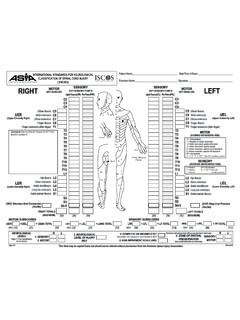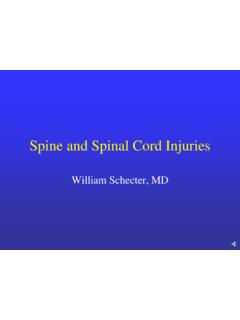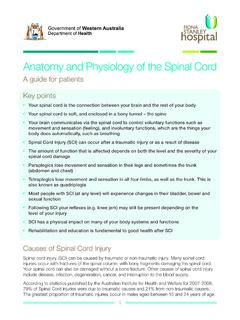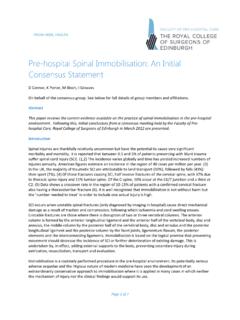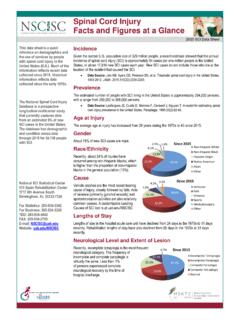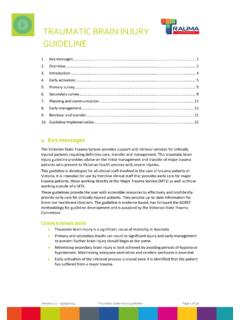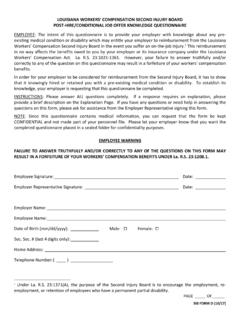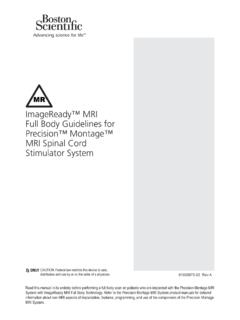Transcription of Asia Iscos Intlworksheet 2019 - American Spinal Injury ...
1 REV 04/19 Page 1/2 This form may be copied freely but should not be altered without permission from the American Spinal Injury LEVELSS teps 1- 6 for classification as on reverse1. SENSORY 2. MOTOR R L 3. NEUROLOGICAL LEVEL OF Injury (NLI)4. COMPLETE OR INCOMPLETE?Incomplete = Any sensory or motor function in S4-55. ASIA IMPAIRMENT SCALE (AIS)(In injuries with absent motor OR sensory function in S4-5 only)6. ZONE OF PARTIALPRESERVATIONMost caudal levels with any innervationSENSORY MOTOR R LMOTOR SUBSCORES SENSORY SUBSCORES UER+UEL= UEMS TOTALLER+ LEL= LEMS TOTALPPR+ PPL= PP TOTALLTR+ LTL= LT TOTALMAX(25)(25)(50)(25)(25)(50)(56)(56) (112)MAXMAX(56)(56)(112)MAX(50)(56)(56)R IGHT TOTALS (MAXIMUM)(56)(56)(50)LEFT TOTALS(MAXIMUM)(VAC) Voluntary Anal Contraction (Yes/No)(DAP) Deep Anal Pressure (Yes/No)C5C6C7C8T1C5C6C7C8T1L2L3L4L5S1L2 L3L4L5S1C2C3C4S2S3S4-5T2T3T4T5T6T7T8T9T1 0T11T12L1C2C3C4S2S3S4-5T2T3T4T5T6T7T8T9T 10T11T12L1 RIGHTLEFTUER(Upper Extremity Right)LER(Lower Extremity Right)
2 UEL(Upper Extremity Left)LEL(Lower Extremity Left) Elbow flexorsWrist extensorsElbow extensorsFinger flexorsFinger abductors (little finger)Hip flexorsKnee extensorsAnkle dorsiflexorsLong toe extensorsAnkle plantar flexorsElbow flexorsWrist extensorsElbow extensorsFinger flexorsFinger abductors (little finger)Hip flexorsKnee extensorsAnkle dorsiflexorsLong toe extensorsAnkle plantar flexors Pin Prick (PPR)Light Touch (LTR)Pin Prick (PPL)Light Touch (LTL)SENSORY KEY SENSORY POINTSMOTORKEY MUSCLESMOTORKEY MUSCLES0 = Absent1 = Altered2 = NormalNT = Not testable0*, 1*, NT* = Non-SCI condition presentSENSORY(SCORING ON REVERSE SIDE) 0 = Total paralysis 1 = Palpable or visible contraction 2 = Active movement, gravity eliminated 3 = Active movement, against gravity4 = Active movement, against some resistance 5 = Active movement, against full resistanceNT = Not testable 0*, 1*, 2*, 3*, 4*, NT* = Non-SCI condition presentMOTOR(SCORING ON REVERSE SIDE)Comments (Non-key Muscle?)
3 Reason for NT? Pain?Non-SCI condition?):C2C2C3C4T3S4-5S3S2S1L5L4L3L2 C3C4T2T4T5T6T7T8T9T10T11T12L1L2L3L4L5C8C 7C6 DorsumPalmKey SensoryPointsPatient NameDate/Time of ExamExaminer Name SignatureINTERNATIONAL STANDARDS FOR NEUROLOGICAL CLASSIFICATION OF Spinal CORD Injury (ISNCSCI)Page 2/2A = Complete. No sensory or motor function is preserved in the sacral segments = Sensory Incomplete. Sensory but not motor function is preserved below the neurological level and includes the sacral segments S4-5 (light touch or pin prick at S4-5 or deep anal pressure) AND no motor function is preserved more than three levels below the motor level on either side of the = Motor Incomplete.
4 Motor function is preserved at the most caudal sacral segments for voluntary anal contraction (VAC) OR the patient meets the criteria for sensory incomplete status (sensory function preserved at the most caudal sacral segments S4-5 by LT, PP or DAP), and has some sparing of motor function more than three levels below the ipsilateral motor level on either side of the body.(This includes key or non-key muscle functions to determine motor incomplete status.) For AIS C less than half of key muscle functions below the single NLI have a musclegrade = Motor Incomplete. Motor incomplete status as defined above, with at least half (half or more) of key muscle functions below the single NLI having a muscle grade = Normal.
5 If sensation and motor function as tested with the ISNCSCI are graded as normal in all segments, and the patient had prior deficits, then the AIS grade is E. Someone without an initial SCI does not receive an AIS ND: To document the sensory, motor and NLI levels, the ASIA Impairment Scale grade, and/or the zone of partial preservation (ZPP) when they are unable to be determined based on the examination Impairment Scale (AIS)Steps in ClassificationMuscle Function GradingSensory GradingWhen to Test Non-Key Muscles:0 = Total paralysis1 = Palpable or visible contraction2 = Active movement, full range of motion (ROM) with gravity eliminated3 = Active movement, full ROM against gravity4 = Active movement, full ROM against gravity and moderate resistance in a muscle specific position5 = (Normal) active movement, full ROM against gravity and full resistance in a functional muscle position expected from an otherwise unimpaired personNT = Not testable ( due to immobilization, severe pain such that the patient cannot be graded, amputation of limb, or contracture of > 50% of the normal ROM)
6 0*, 1*, 2*, 3*, 4*, NT* = Non-SCI condition present a0 = Absent 1 = Altered, either decreased/impaired sensation or hypersensitivity2 = Normal NT = Not testable 0*, 1*, NT* = Non-SCI condition present aIn a patient with an apparent AIS B classification, non-key muscle functions more than 3 levels below the motor level on each side should be tested to most accurately classify the Injury (differentiate between AIS B and C).The following order is recommended for determining the classification of individuals with STANDARDS FOR NEUROLOGICAL CLASSIFICATION OF Spinal CORD INJURYM ovementShoulder: Flexion, extension, adbuction, adduction,internal and external rotationElbow: SupinationElbow: PronationWrist: FlexionFinger: Flexion at proximal joint, extensionThumb: Flexion, extension and abduction in plane of thumbFinger: Flexion at MCP jointThumb: Opposition, adduction and abductionperpendicular to palmFinger: Abduction of the index fingerHip: AdductionHip: External rotationHallux and Toe: DIP and PIP flexion and abductionHallux.
7 AdductionHip: Extension, abduction, internal rotationKnee: FlexionAnkle: Inversion and eversionToe: MP and IP extensionRoot levelC5C6C7C8T1L2L3L4L5S14. Determine whether the Injury is Complete or Incomplete.( absence or presence of sacral sparing) If voluntary anal contraction = No AND all S4-5 sensory scores = 0 AND deep anal pressure = No, then Injury is Complete. Otherwise, Injury is Incomplete. 6. Determine the zone of partial preservation (ZPP).The ZPP is used only in injuries with absent motor (no VAC) OR sensory function (no DAP, no LT and no PP sensation) in the lowest sacral segments S4-5, and refers to those dermatomes and myotomes caudal to the sensory and motor levels that remain partially innervated.
8 With sacral sparing of sensory function, the sensory ZPP is not applicable and therefore NA is recorded in the block of the worksheet. Accordingly, if VAC is present, the motor ZPP is not applicable and is noted as NA .3. Determine the neurological level of Injury (NLI).This refers to the most caudal segment of the cord with intact sensation and antigravity (3 or more) muscle function strength, provided that there is normal (intact) sensory and motor function rostrally NLI is the most cephalad of the sensory and motor levels determined in steps 1 and Determine motor levels for right and left by the lowest key muscle function that has a grade of at least 3 (on supine testing), providing the key muscle functions represented by segments above that level are judged to be intact (graded as a 5).
9 Note: in regions where there is no myotome to test, the motor level is presumed to be the same as the sensory level, if testable motor function above that level is also Determine sensory levels for right and left sensory level is the most caudal, intact dermatome for both pin prick and light touch sensation. a Note: Abnormal motor and sensory scores should be tagged with a * to indicate an impairment due to a non-SCI condition. The non-SCI condition should be explained in the comments box together with information about how the score is rated for classification purposes (at least normal / not normal for classification).
10 5. Determine ASIA Impairment Scale (AIS) Injury Complete? If YES, AIS=AIs Injury Motor Complete? If YES, AIS=BAre at least half (half or more) of the key muscles below the neurological level of Injury graded 3 or better?If sensation and motor function is normal in all segments, AIS=ENote: AIS E is used in follow-up testing when an individual with a documented SCI has recovered normal function. If at initial testing no deficits are found, the individual is neurologically intact and the ASIA Impairment Scale does not apply.(No=voluntary anal contraction OR motor function more than three levels below the motor level on a given side, if the patient has sensory incomplete classification)
